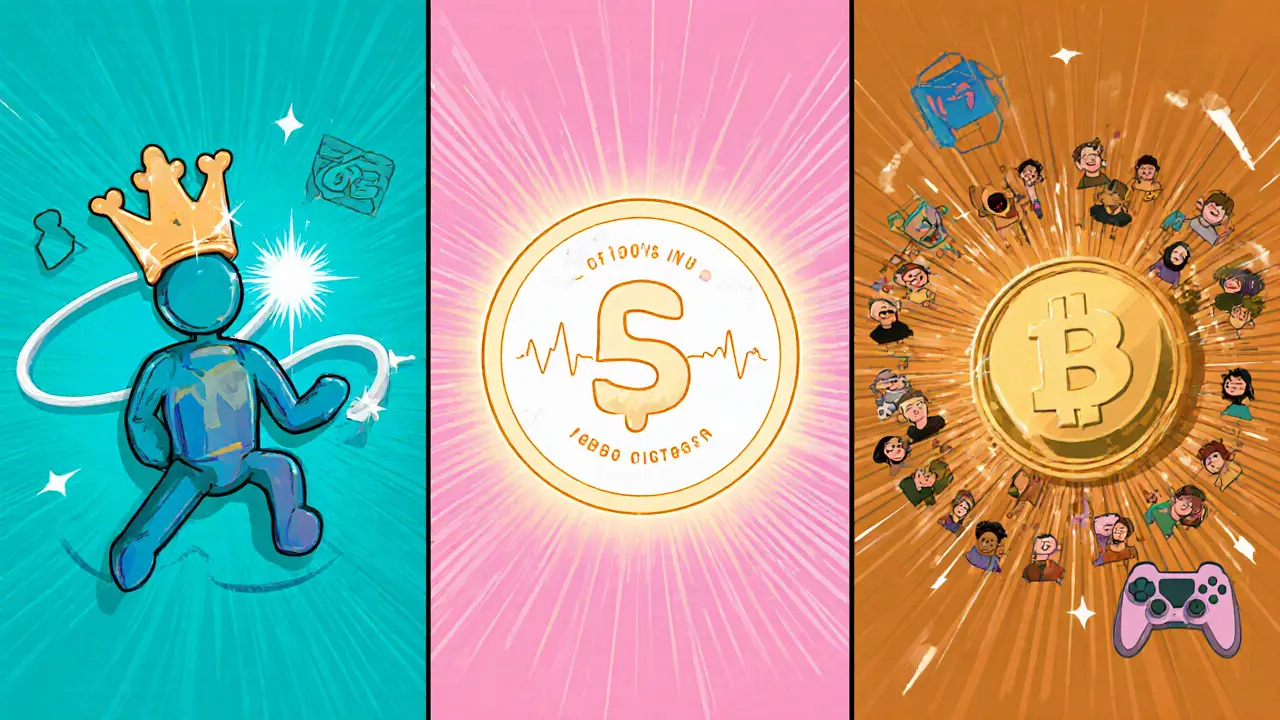Blockchain Content Monetization Calculator
Potential Monthly Earnings
NFT Sales + Royalties
$0.00
Based on 10% royalty rate
Subscription Tokens
$0.00
Monthly recurring revenue
Social Tokens
Community-driven value
How It Works
This calculator estimates potential earnings using typical Web3 monetization models:
- NFT Sales + Royalties: Based on fixed royalty rate from secondary sales
- Subscription Tokens: Estimated monthly token holder value
- Social Tokens: Projected community investment value
Note: Actual earnings depend on audience engagement, content quality, and platform adoption.
| Benefit | Typical Impact | Supporting Data |
|---|---|---|
| Higher Revenue Share | Creators keep 70-90% of sales | Friend.tech top earners pocket $1-2M monthly |
| Instant, Border-less Payouts | Payments settle in seconds, fees < 1 cent | Base Chain and Polygon reduce gas costs |
| Transparent Royalty Enforcement | Smart contracts ensure automatic payouts | Immutable record of all transactions |
Creators are hunting for ways to keep more of what they make, and the rise of blockchain content monetization is reshaping the playing field. No longer confined to ad dollars or platform cuts, artists, writers, and gamers can now lock revenue directly into code that never changes.
What are blockchain content monetization models?
Blockchain content monetization models are financial structures that use decentralized ledgers to let creators sell, license, or reward digital work without a middle‑man. The blockchain records every transaction, enforces royalty rates, and settles payments in seconds, giving creators transparent, immutable proof of earnings.
Core building blocks
NFT is a non‑fungible token that represents a unique digital asset on a blockchain. Whether it’s a piece of art, a video clip, or an in‑game skin, an NFT can be programmed to pay the creator a percentage every time it changes hands.
Smart contract is a self‑executing code that runs on a blockchain and automatically enforces the terms of a deal. Creators embed royalty percentages, access conditions, or unlock schedules directly into the contract, so no one can retroactively alter the payout rules.
Layer 2 is a scaling solution that processes transactions off the main chain to lower fees and speed up settlement. Platforms like Base Chain and Polygon have pushed transaction costs below a cent, making micropayments viable for everyday fans.
Popular monetization models
- NFT sales + royalties: Mint a limited edition, earn a fixed royalty (often 5‑10%) on every resale.
- Subscription tokens: Issue a token that grants ongoing access to a creator’s vault; token holders receive continuous content as long as they own the token.
- Social tokens: Fans buy a token that represents a stake in the creator’s brand; price fluctuations reflect community sentiment and unlock perks.
- Play‑to‑earn ecosystems: Embed in‑game rewards that can be cashed out, turning player activity into creator revenue.
- Hybrid Web2‑Web3 (e.g., TOKN): Layer a token on top of existing platforms like YouTube or TikTok, letting creators receive crypto payouts while the audience stays on familiar interfaces.
Real‑world examples
Zora is a protocol that lets creators mint NFTs with built‑in royalty enforcement. Artists on Zora keep up to 90% of secondary‑sale revenue, a stark contrast to the 30%‑plus cuts on many traditional marketplaces.
Base Chain provides a Layer‑2 environment that reduces gas fees to near‑zero for creators. By moving minting and sales off‑chain, creators can price NFTs under a dollar and still retain most earnings.
Friend.tech introduced social tokens that let fans invest in a creator’s personal brand. Since August2023 the platform has generated >$250million in sales, with top creators pulling $1‑2million per month purely from transaction fees.
TIME Magazine ran an NFT‑gated article series and saw a 30% rise in premium content engagement plus a 22% quarter‑over‑quarter revenue boost.
TOKN is a research‑backed hybrid framework that tokenizes creator work across Web2 channels. Early pilots report a 3‑fold increase in unlock rates compared with classic paywalls.

Why creators prefer blockchain models
| Benefit | Typical impact | Supporting data |
|---|---|---|
| Higher revenue share | Creators keep 70‑90% of sales | Friend.tech top earners pocket $1‑2M monthly |
| Instant, border‑less payouts | Payments settle in seconds, fees <70% | Micropayments cut settlement time from days to <1s |
| Programmable royalties | Earn on every resale | Zora enforces 5‑10% secondary royalties automatically |
| Ownership‑driven engagement | Higher NPS and repeat purchases | NFT holders show 20% higher retention vs. subscribers |
Challenges to watch
The biggest roadblock is onboarding. Studies show 70% of potential fans abandon the process during wallet creation. Complex gas‑fee estimation and contract interaction can also scare non‑tech users.
Regulatory uncertainty adds another layer of risk. Tokens can be classified as securities in some jurisdictions, so creators must stay informed about local compliance rules.
Step‑by‑step checklist for creators
- Choose a blockchain that matches your audience (Ethereum for broad reach, Polygon or Base Chain for low fees).
- Set up a user‑friendly wallet (MetaMask, Trust Wallet, or a custodial option).
- Select a platform that offers guided minting (Zora, Base Chain, or a hybrid like TOKN).
- Define your revenue model - pure NFT sale, royalty‑based, subscription token, or social token.
- Write a clear smart‑contract clause for royalties (5‑10% is common).
- Launch a “loyalty pass” NFT for early adopters to lower friction.
- Promote via existing social channels; embed wallet links and QR codes in posts.
- Monitor analytics - track resale volume, royalty income, and community sentiment.
- Iterate: adjust token supply, royalty rates, or add new utility (e.g., exclusive Discord access).
Creators who start small, test with a free loyalty pass, and then scale to full‑price NFTs usually see the smoothest adoption curve.
Future outlook
Market forecasts peg the blockchain content monetization sector at $659million in 2025 and nearly $2.74billion by 2030, driven by creator‑led demand for higher payouts and the rise of digital wallets in Asia‑Pacific (70% of e‑commerce now uses wallets). Hybrid solutions that marry Web2 discoverability with Web3 payout mechanics are expected to dominate, as they mitigate the biggest user‑experience pain points while still delivering programmable royalties.
Frequently Asked Questions
What is the biggest advantage of using NFTs for content?
NFTs let creators embed a royalty clause directly into the asset, so they earn a percentage every time the work is resold, something traditional platforms can’t guarantee.
Do I need to know how to code smart contracts?
Not necessarily. Platforms like Zora and Base Chain provide no‑code minting tools that automatically generate royalty‑enforcing contracts behind the scenes.
How do social tokens differ from regular NFTs?
Social tokens represent a share in a creator’s brand or community influence, often fluctuating in price based on fan sentiment, whereas NFTs are unique items with fixed scarcity.
Can I sell content on both a traditional platform and a blockchain platform?
Yes. Hybrid models like TOKN let you tokenize a YouTube video while still hosting it on YouTube, letting you collect crypto on top of ad revenue.
What are the main security concerns for creators?
Protect your private keys, enable two‑factor authentication on wallets, and use reputable platforms that audit their smart contracts regularly.


17 Responses
Blockchain royalties are automatically enforced by smart contracts, so creators get paid each time their NFTs change hands.
Yo, if you wanna get real cash from ur art, try out those subscription token models – they’re pretty simple and it’s a great way to keep the fans engaged, even if you manchever some details.
Oh great, another "revolutionary" way to make money that will probably crash once the hype dies. Yeah, because crypto never loses value.
Listen up everyone; the real advantage here is the speed of payouts; transactions settle in seconds; fees are almost negligible; it’s a game‑changer for creators worldwide!!!
When evaluating the macro‑economic implications of decentralized content monetization frameworks, it is essential to consider the confluence of tokenomics, liquidity provisioning, and community governance structures. The emergence of royalty‑centric smart contracts introduces immutable fiscal streams that circumvent traditional intermediary bottlenecks. Moreover, the integration of programmable subscription tokens facilitates a recurring revenue model that aligns stakeholder incentives across the value chain. In practice, creators can leverage utility‑driven token issuance to reward early adopters while simultaneously fostering network effects through token‑gated experiences. The scalability of layer‑2 solutions, such as Polygon, reduces gas overhead, thereby democratizing access for artists operating on thin margins. Empirical data from platforms like Friend.tech suggest top earners can achieve multi‑million dollar monthly turnovers, underscoring the revenue amplification potential inherent in these systems. However, one must also account for market volatility, which can erode nominal gains when token valuations fluctuate sharply. Risk mitigation strategies, including diversified token portfolios and hedging mechanisms, become paramount in preserving creator wealth. From a legal perspective, transparent royalty enforcement via blockchain mitigates disputes, but jurisdictional nuances around digital asset classification remain unresolved. Accordingly, creators should seek counsel to navigate the regulatory landscape, particularly concerning securities law implications. Community‑driven governance models empower token holders to influence platform development, fostering a sense of ownership that can translate into heightened retention rates. The psychosocial dimension of social tokens also cannot be overlooked; they engender a sense of belonging that traditional fan clubs struggle to replicate. To maximize earnings, creators should adopt a hybrid approach, combining NFT drops, subscription streams, and social token ecosystems, thereby capturing revenue from both primary sales and secondary market activity. Continuous analytics, leveraging on‑chain data dashboards, enable creators to iterate on pricing strategies in real time, optimizing both price elasticity and royalty configurations. Ultimately, the confluence of transparent smart contract enforcement, low‑friction cross‑border payouts, and community‑centric token design heralds a paradigm shift in content monetization, provided creators navigate the associated technical and regulatory complexities with diligence.
Hey guys, just wanted to say that these blockchain tools can really help indie musicians who don’t have label backing. It’s a cool way to keep more of the money.
Whoa, this is like the holy grail for creators! Imagine the drama when you finally cash out those NFTs and your audience’s jaws hit the floor.
Honestly, if you’re not embracing these models, you’re basically choosing to stay in the dark ages. The future belongs to those who understand token economics.
It’s evident that the decentralized paradigm supersedes conventional platforms; however, the underlying infrastructure still suffers from sporadic latency issues, which, frankly, is unacceptable for high‑frequency creators.
There is a beautiful optimism in the notion that creators can directly engage with their supporters without a middleman. This aligns with the philosophical ideal of authentic exchange. By tokenizing content, we create a tangible representation of value that can be measured, transferred, and appreciated in real time. It encourages a reciprocal relationship where fans become stakeholders, fostering a sense of community and shared destiny. While the technology is still maturing, the underlying principle remains a beacon of hope for artistic autonomy.
Stop pretending this is a silver bullet. The volatility alone makes it a risky gamble, and most creators will lose more than they gain.
From a rigorous analytical standpoint, the premise is fundamentally flawed; nonetheless, I’m tempted to invest a modest sum 🙂
For anyone looking to dive deeper, consider checking out the recent study on token velocity and its impact on creator earnings-some fascinating metrics in there.
I appreciate the balanced overview; it’s helpful to see both potentials and pitfalls before deciding on a strategy.
Wow, another hype train. Let’s see how long this one lasts before we all get burned.
This whole blockchain buzz is like a kaleidoscope of dazzling possibilities, but it also hides a labyrinth of hidden fees and technical quagmires that can trip up even the savviest creators.
Cool concept.